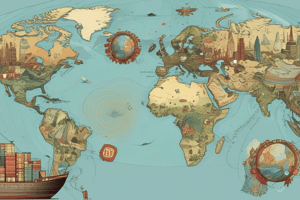Podcast
Questions and Answers
What percentage of world output is produced by high-income countries?
What percentage of world output is produced by high-income countries?
- 74%
- 77%
- 81% (correct)
- 76%
Which group of countries contributes the least to world imports and exports?
Which group of countries contributes the least to world imports and exports?
- High-income countries
- Low-income countries (correct)
- Upper-middle-income countries
- Middle-income countries
What accounts for the majority of imports and exports in high-income countries?
What accounts for the majority of imports and exports in high-income countries?
- Service-based goods
- Crude oil
- Manufactured goods (correct)
- Agricultural products
What is the approximate percentage of world exports contributed by middle-income countries?
What is the approximate percentage of world exports contributed by middle-income countries?
Why is there a significant difference in trade levels between middle-income and high-income countries?
Why is there a significant difference in trade levels between middle-income and high-income countries?
What percentage of world imports is attributed to middle-income countries?
What percentage of world imports is attributed to middle-income countries?
How do low-income countries compare to middle-income countries in terms of export percentages?
How do low-income countries compare to middle-income countries in terms of export percentages?
What is the main characteristic of the trade distribution among countries at different income levels?
What is the main characteristic of the trade distribution among countries at different income levels?
Which of the following best describes the nature of goods in international trade?
Which of the following best describes the nature of goods in international trade?
What is the primary reason why international trade in services can be more challenging to measure than trade in goods?
What is the primary reason why international trade in services can be more challenging to measure than trade in goods?
In the context of international trade, which of the following is considered 'visible trade'?
In the context of international trade, which of the following is considered 'visible trade'?
Which of these economies had the lowest percentage of world total service exports in 2002?
Which of these economies had the lowest percentage of world total service exports in 2002?
Which country has the largest economy in the world?
Which country has the largest economy in the world?
Which of the following best describes 'invisible trade'?
Which of the following best describes 'invisible trade'?
Which of the following statements about international trade is accurate?
Which of the following statements about international trade is accurate?
What period saw a 266% increase in global trade in goods?
What period saw a 266% increase in global trade in goods?
Which of the following best describes the dual nature of international economics?
Which of the following best describes the dual nature of international economics?
What aspect of international economics allows foreign conditions to influence the domestic economy?
What aspect of international economics allows foreign conditions to influence the domestic economy?
Which of the following is NOT a focus of international economics?
Which of the following is NOT a focus of international economics?
What is the significance of national and political boundaries in international economics?
What is the significance of national and political boundaries in international economics?
How does international economics extend the study of microeconomics?
How does international economics extend the study of microeconomics?
What concept describes the allocation of scarce resources to satisfy unlimited human wants?
What concept describes the allocation of scarce resources to satisfy unlimited human wants?
What is a primary study focus of microeconomics within international economics?
What is a primary study focus of microeconomics within international economics?
Which country has the highest percentage of exports to GDP according to the data provided?
Which country has the highest percentage of exports to GDP according to the data provided?
What does a high ratio of exports to GDP indicate about a country's economy?
What does a high ratio of exports to GDP indicate about a country's economy?
According to the Globalization Index, which of the following aspects is NOT considered for quantifying economic integration?
According to the Globalization Index, which of the following aspects is NOT considered for quantifying economic integration?
Which country listed has the lowest exports as a percentage of GDP?
Which country listed has the lowest exports as a percentage of GDP?
Which of the following countries has an exports to GDP percentage closest to 50%?
Which of the following countries has an exports to GDP percentage closest to 50%?
What is the exports to GDP percentage for Malaysia as per the provided data?
What is the exports to GDP percentage for Malaysia as per the provided data?
Which country has an exports to GDP percentage that is exactly the same as Finland?
Which country has an exports to GDP percentage that is exactly the same as Finland?
Which country has an exports to GDP percentage greater than 120% but less than 150%?
Which country has an exports to GDP percentage greater than 120% but less than 150%?
What is defined as the purchase of financial assets such as stocks and bonds in a foreign country?
What is defined as the purchase of financial assets such as stocks and bonds in a foreign country?
Which type of capital flow accounted for the largest percentage of the total foreign direct investment in high-income economies?
Which type of capital flow accounted for the largest percentage of the total foreign direct investment in high-income economies?
What is the term for the market where different currencies are bought and sold?
What is the term for the market where different currencies are bought and sold?
Which of the following growth rates for GDP was the highest for middle-income economies between 1990 and 2000?
Which of the following growth rates for GDP was the highest for middle-income economies between 1990 and 2000?
What percentage of the world total foreign direct investment was allocated to low-income economies?
What percentage of the world total foreign direct investment was allocated to low-income economies?
Which of the following best describes multinational corporations (MNCs)?
Which of the following best describes multinational corporations (MNCs)?
In which time period did low-income economies experience the highest growth rate of exports of goods and services?
In which time period did low-income economies experience the highest growth rate of exports of goods and services?
What is the exchange rate?
What is the exchange rate?
Which category of economies had the lowest percentage of total foreign direct investment?
Which category of economies had the lowest percentage of total foreign direct investment?
What does the term 'globalization' primarily refer to in the context of the world economy?
What does the term 'globalization' primarily refer to in the context of the world economy?
Flashcards are hidden until you start studying
Study Notes
Global Trade Increase
- Between 1975 and 2002, global trade in goods increased 266%
- Companies recognized international transactions as being equally or more important than domestic transactions
- International Economics helps explain the patterns of international transactions.
Microeconomics and Macroeconomics
- Microeconomics focuses on the production and consumption of goods and services, studying individual industries and markets.
- Macroeconomics analyzes the operation of the entire economy, including factors influencing overall economic output.
International Economics
- It examines the allocation of resources to production, distribution, and consumption of goods and services globally.
- International economics combines elements of microeconomics and macroeconomics.
- It extends microeconomic study by examining the differences between domestic and international trade.
- It extends macroeconomics by allowing foreign economic conditions to influence the domestic economy and considering how government policies can affect international trade sectors.
Scope of International Economics
- Covers the production, distribution, and consumption of goods, services, and capital worldwide.
- National and political boundaries create legal, linguistic, social, currency barriers to trade, and different economic policies.
- Requires both micro and macro economic analysis.
Economics Concept and Distribution of World Output
- Economics is the study of how societies allocate scarce resources to satisfy unlimited human wants.
- High-income countries produce approximately 81% of the world’s output.
- Middle-income countries produce approximately 16% of the world’s output.
- Low-income countries produce approximately 3% of the world’s output.
- The distribution of merchandise trade reflects the distribution of world output.
- High-income countries account for 76% of world imports and 77% of world exports.
- Middle-income countries account for 21% of world imports and 23% of world exports.
- Low-income countries provide approximately 3% of world exports and imports.
- There is a difference between output and trade figures for middle-income and high-income countries, primarily due to oil exports from middle-income countries.
Imports and Exports of Goods
- Exports are goods and services produced domestically but sold to residents of other countries.
- Imports are goods and services produced or invested in foreign countries, but purchased by residents of a specific country.
International Trade
- A critical component of the global economy.
- International trade in services is growing faster than trade in goods.
- Many careers are influenced by international trade in services.
International Trade in Services
- Visible trade refers to the exchange of goods.
- Service trade (invisible trade) includes transportation, insurance, and tourism.
- Measuring service trade is more challenging compared to goods trade.
World's Largest Economies
- The United States, Japan, and Germany are the world’s three largest economies.
- The U.S. economy is more than twice the size of Japan’s and more than four times the size of Germany’s.
Capital Flows
- Multinational Corporations (MNCs) operate production and distribution facilities in several countries.
- Portfolio Capital (investment) involves purchasing foreign financial assets like stocks and bonds.
- Foreign Direct Investment (FDI) occurs when domestic corporations acquire real assets in foreign countries, like plants and equipment.
Foreign Exchange Market
- The foreign exchange market enables the buying and selling of currencies.
- The exchange rate reflects the price of one currency in terms of another.
Trends in International Production and Trade
- Globalization signifies the growing influence of international factors on the world economy.
- The ratio of exports to GDP is a simple measure of globalization.
- Countries with a high ratio of exports to GDP are more open to international trade.
Globalization Index
- The Foreign Policy Magazine Globalization Index incorporates 16 key indicators of global integration.
- It quantifies economic integration by considering trade, foreign direct investment, portfolio capital flow, tourism, income earned and paid abroad, and other factors.
Studying That Suits You
Use AI to generate personalized quizzes and flashcards to suit your learning preferences.



